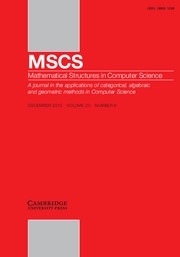Crossref Citations
This article has been cited by the following publications. This list is generated based on data provided by
Crossref.
Borgström, Johannes
Gutkovas, Ramūnas
Parrow, Joachim
Victor, Björn
and
Pohjola, Johannes Åman
2014.
Trustworthy Global Computing.
Vol. 8358,
Issue. ,
p.
103.
Borgström, Johannes
Gutkovas, Ramūnas
Parrow, Joachim
Victor, Björn
and
Pohjola, Johannes Åman
2014.
Trustworthy Global Computing.
Vol. 8358,
Issue. ,
p.
103.
Borgstrom, Johannes
Gutkovas, Ramūnas
Rodhe, Ioana
and
Victor, Björn
2015.
The Psi-Calculi Workbench.
ACM Transactions on Embedded Computing Systems,
Vol. 14,
Issue. 1,
p.
1.
Borgström, Johannes
Huang, Shuqin
Johansson, Magnus
Raabjerg, Palle
Victor, Björn
Åman Pohjola, Johannes
and
Parrow, Joachim
2015.
Broadcast psi-calculi with an application to wireless protocols.
Software & Systems Modeling,
Vol. 14,
Issue. 1,
p.
201.
Maksimović, Petar
and
Schmitt, Alan
2015.
Interactive Theorem Proving.
Vol. 9236,
Issue. ,
p.
278.
Bengtson, Jesper
Parrow, Joachim
and
Weber, Tjark
2016.
Psi-Calculi in Isabelle.
Journal of Automated Reasoning,
Vol. 56,
Issue. 1,
p.
1.
MOMIGLIANO, ALBERTO
PIENTKA, BRIGITTE
and
THIBODEAU, DAVID
2019.
A case study in programming coinductive proofs: Howe’s method.
Mathematical Structures in Computer Science,
Vol. 29,
Issue. 8,
p.
1309.
Lybech, Stian
2022.
Encodability and Separation for a Reflective Higher-Order Calculus.
Electronic Proceedings in Theoretical Computer Science,
Vol. 368,
Issue. ,
p.
95.
Bendixen, Alex Rønning
Bojesen, Bjarke Bredow
Hüttel, Hans
and
Lybech, Stian
2022.
A Generic Type System for Higher-Order Ψ-calculi.
Electronic Proceedings in Theoretical Computer Science,
Vol. 368,
Issue. ,
p.
43.
Hüttel, Hans
Lybech, Stian
Bendixen, Alex R.
and
Bojesen, Bjarke B.
2024.
A generic type system for higher-order Ψ-calculi.
Information and Computation,
Vol. 300,
Issue. ,
p.
105190.
Lybech, Stian
2024.
The reflective higher-order calculus: Encodability, typability and separation.
Information and Computation,
Vol. 297,
Issue. ,
p.
105138.


